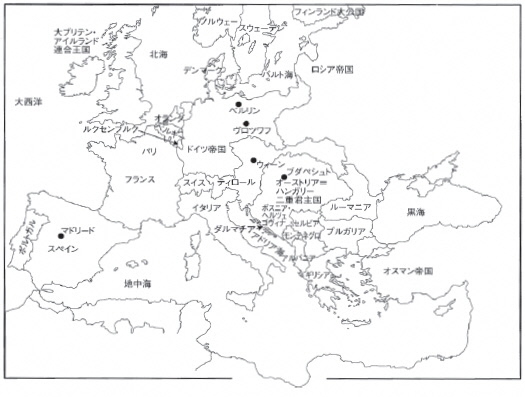本文
Germany and Austria-Hungary
The German Empire
Germany was a federation of loosely connected states known as the Holy Roman Empire and the German Confederation for many years. The Kingdom of Prussia extended its power in the 19th century and achieved unification in 1871 following the Austro-Prussian War of 1866 and the Franco-Prussian War of 1870–1871. Its territory went far beyond the current German borders reaching what is now France, Denmark, Poland and some parts of Lithuania. Otto von Bismarck (1815–1898), the Prime Minister of the Kingdom of Prussia and later the Prime Minister of the German Empire, devoted his energies to the unification of Germany under the Kingdom of Prussia. Von Bismarck pushed for domestic modernization under Kaiser Wilhelm I (reign 1871–1888) and took a diplomatic approach with foreign countries to ease their cautiousness toward Germany. This was meant to isolate France, which was vengeful against Prussia (Germany), and he formed the Triple Alliance in 1882 with Austria-Hungary and Italy.
Economically speaking, Germany succeeded in its industrial revolution and even surpassed Great Britain in steel production, but was surpassed by Great Britain and France in terms of advancing into foreign countries and acquiring foreign colonies. To propel Germany to a higher position on the world stage, Wilhelm II (reign 1888–1918), the third Kaiser, expelled Bismarck from his post and shifted to an active expansionist foreign policy. In the two Moroccan crises (1905 and 1911), Wilhelm II conflicted sharply with France and leased Jiaozhou Bay as a base in the Far East to develop Qingdao as a colonized city. This foreign policy by Wilhelm II led to confrontation with Great Britain, France and Russia, the parties to the entente.

Map: Europe on the eve of World War I (Taken from the maps (overall view 7) at the end of An Introduction to Habsburg History Research by Atsushi Otsuru)
The Austro-Hungarian Empire
At that time, the territory of the Austro-Hungarian Empire had spread to the Czech Lands (Bohemia and Moravia), Slovakia, the former Yugoslavia (Croatia, Slovenia and Bosnia-Herzegovina), and Italy and parts of Poland, as well as what is now Austria and Hungary. After Rudolf I of Habsburg (reign 1273–1291) obtained control of Austria, the territory of the House of Habsburg expanded to the surrounding areas, including the Czech Lands and Hungary. In the late 17th century, the Habsburg Empire repulsed the attacks of the Ottoman Empire and became a great power in Central Europe. This empire included many territories with diverse populations.
In 1867, the Habsburg Empire established the unique Austro-Hungarian Compromise (Ausgleich in German) under the dual monarchy of Franz Joseph I (reign 1848–1916). Austria and Hungary had their own governments, but diplomacy, military affairs and finances were considered common national services and common ministries were arranged for each of the services. Troops conscripted from across the empire also reflected the racial diversity within the empire.

Image: The Ausgleich system (Atsushi Otsuru, The World of the Aonogahara Prisoner of War Camp, p. 20.)

Map: An illustrated distribution of races in Austria-Hungary by language (Atsushi Otsuru, The World of the Aonogahara Prisoner of War Camp, p. 19)









